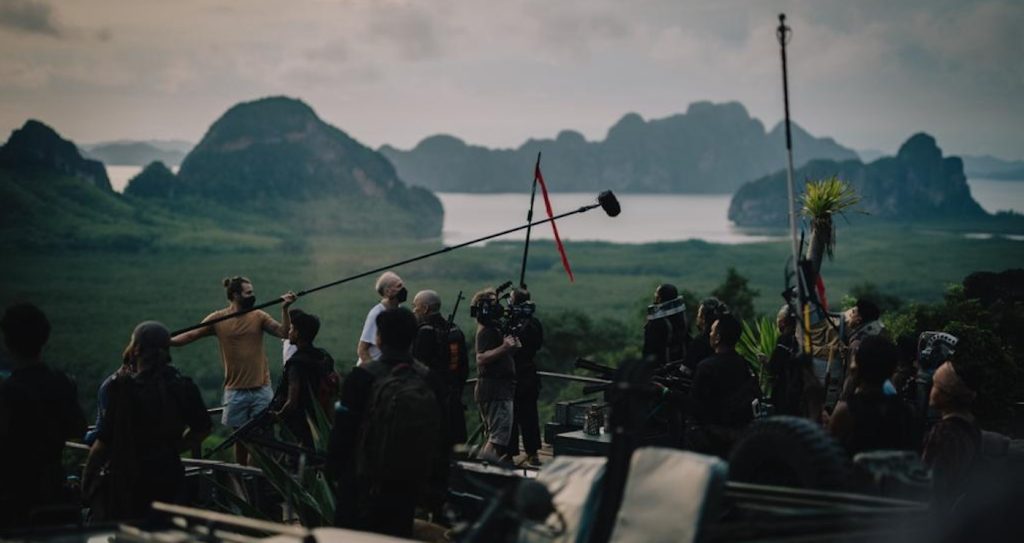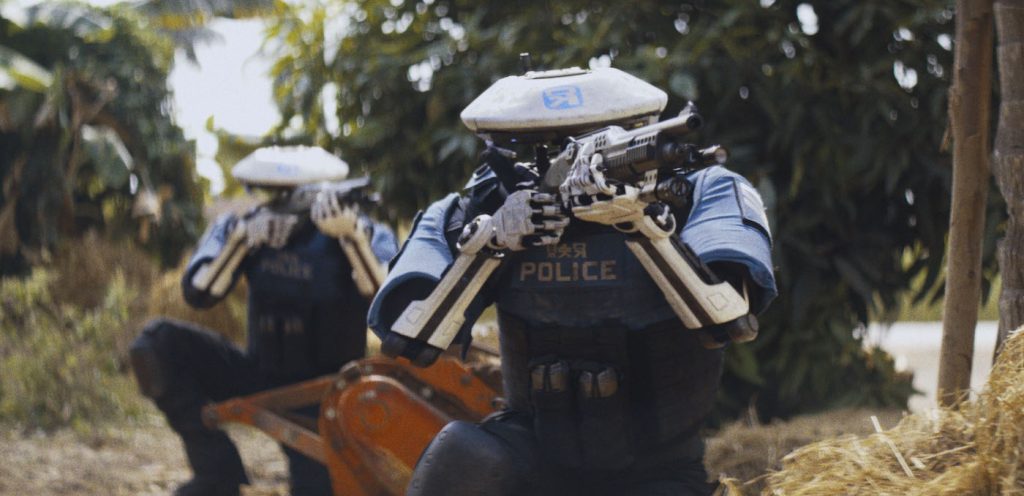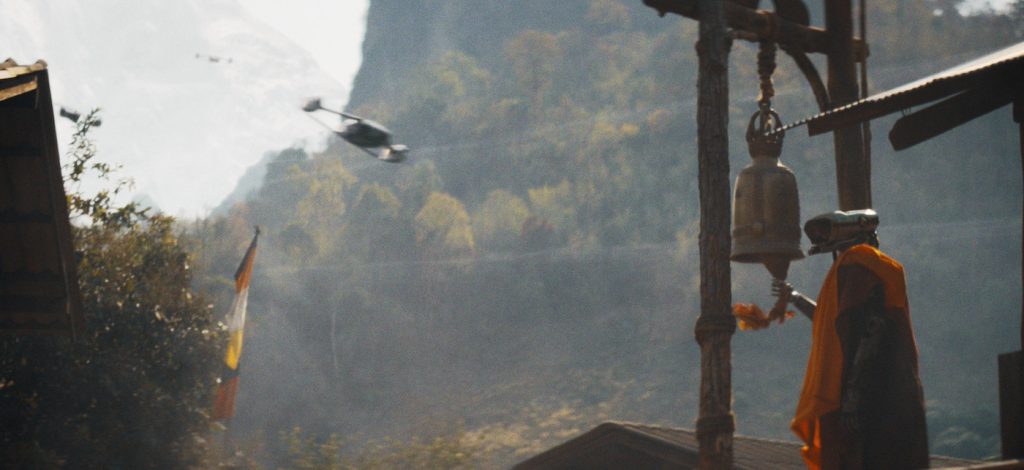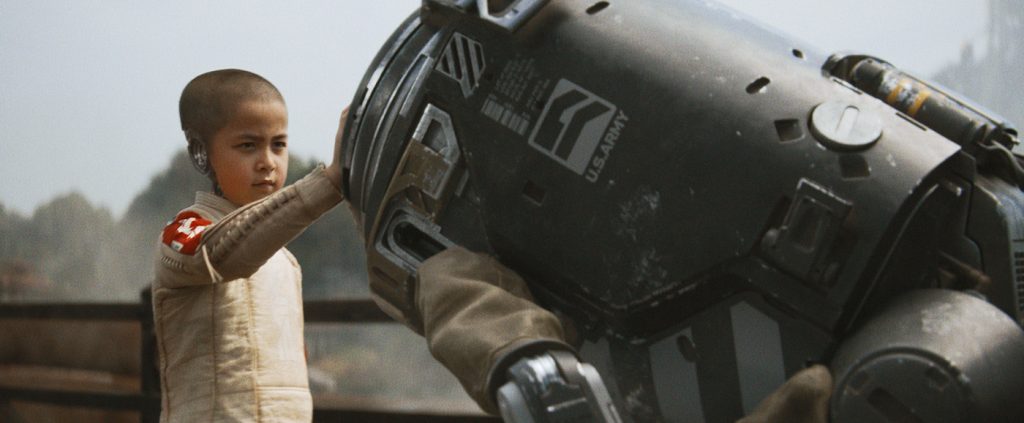“The Creator” Oscar-Nominated Sound Team on Blending Retro-Futurism, Robot Monks, & the Didgeridoo
The Creator‘s Oscar-nominated supervising sound editors, Erik Aadahl and Ethan Van der Ryn, had a dream experience creating the soundscape for director Gareth Edwards‘ vision of a nightmarish future. The timing of the film couldn’t have been better—The Creator is set at a point in human history where there’s an outright war between humanity and artificial intelligence, a classic sci-fi set-up that felt alarmingly less fictive given the rapid expansion of AI in our real world. Yet The Creator puts a human face on the algorithms of doom, namely that of a young girl named Alphie (Madeleine Yuna Voyles), who is believed to be an artificial agent of doom by the militant humans in command. John David Washington’s Joshua, an ex-special forces agent grieving his wife’s disappearance (Gemma Chan), is recruited to take Alphie out, but complications arise when he’s confronted with the increasingly obvious reality that it’s human beings, not machines, that are rushing the world towards oblivion.
The Creator benefits immensely from the fact it was shot on location across multiple countries, including Nepal, Thailand, Vietnam, Cambodia, and Laos, grounding the high-concept technology in lush, lived-in reality, achieving a retro-futurism that stands apart from most sci-fi films you’ve seen. “Sound is so powerful in terms of evoking sort of these subliminal emotions,” Aadahl says. “It was either Walter Murch or Randy Thom who said that while images come in through the front door, sound comes in through the back door.”
The Creator‘s sound achieves this level of subconscious potency. We spoke to the Oscar nominees about their process, what makes Gareth Edwards a sound designer’s dream, and what it takes to design a new kind of sci-fi sound.
Let’s first dig into the naturalism of The Creator. You can really feel that it was filmed in real environments—how are you blending in those natural sounds with the advanced technology depicted?
Ethan: Gareth’s whole idea of the movie was as if James Cameron and Terrence Malick had a baby. Creating the physical reality and believability is so crucial in a film like this, which has this high-concept future technology. In order to make it all believable, we have to make the audience believe in this whole world, which starts with the natural world. We recorded real sounds in real places with real people and then brought these sounds back into the studio. And in reality, this is what we’re always doing with our work. But this film just created this incredible opportunity because we’re not used to seeing these big movies that are shot in real places with real people. We felt an extra responsibility to really make it sing with the sound design.

The Creator deals with fundamental sci-fi concepts and themes, yet there’s something really different about the way these robots and artificially intelligent androids sound. What was the approach to differentiating how The Creator’s non-human world sounded from other sci-fi films?
Erik: Gareth’s vision of the future is that not everything is the most high-tech thing you can imagine. Just look at now—we have the iPhone, but we also have normal telephones, we have advanced computers, but then we’ve got gas-powered cars. We have a whole mix of technologies, and why would the future be any different? So, not every robot is going to be like the most advanced new iPhone; there’s going to be what Gareth called the Sony Walkman version of robots. So yes, we have super high-concept sci-fi, but we also have something we called retro-futurism, and this was something Gareth really loved playing with. The police robots, for example, or the bomb robots. These were the Sony Walkman versions of technology. This is such a high-tech movie, but it feels like it could have been made in the 70s, and that’s really unique.

Ethan: I’ll add that in regards to referencing other sci-fi films, there were a couple of clear references, including THX-1138 [George Lucas’s first sci-fi film], and then there were references like Apocalypse Now, which influenced the jet helicopters, and we definitely wanted that sort of retro vibe fused with a technology vibe. But then the other side of it was there was the direction to come up with sounds that haven’t been heard before in any other movies. We need to come up with something completely fresh. That kind of direction we love, but it also creates a massive challenge.
Did Gareth ever give you specific notes on how he wanted a particular robot or ship to sound?
Erik: The way that Gareth directs with sound is by not saying, ‘Make it sound like this movie,’ but rather it’s more of a feeling. For example, there’s the Nomad, the orbital space station that goes across the globe and emits these blue beams that are used to track and target AI bases and locations and then bomb them. When Gareth was describing what he wanted to evoke with those blue beams, he didn’t reference a particular sound, instead he said that it should sound like it would give you cancer if you put your hand in the beam for too long. To me that’s the best kind of direction you can get. What he means is it’s volatile, it’s dangerous, it’s radioactive, and then we reverse engineer those feelings sonically.
Ethan: What makes Gareth such an amazing director for sound designers is that one of his credos is that in every moment, we have a series of choices we can make, and I want us as a team to make the unexpected choice, the more dangerous choice. That’s unbelievable to get that kind of direction. Intead of recreating what’s already been done, we’re creating something brand new.
What’s so interesting is that sci-fi, probably more so than any other genre, has iconic sounds that are a part of our collective consciousness, whether it’s the whoosh of a lightsaber or the scream of a TIE Fighter or even HAL 9000’s eerily calm voice in 2001: A Space Odyssey. So, how do you approach trying to create something totally new?
Erik: The very first sequence that Gareth sent us was the floating village tank battle. We got it in, and it was a 15-minute sequence with no temp music and no visual effects. There was gorgeous, David Lean-style photography, though. And the battle starts, and there was just this font that came across the screen that read tank. Working without image is challenging, but it’s also very freeing because you can start to experiment and dance around with ideas and free associate. We wanted a sound that you could close your eyes, and it had a tank-like quality. We played with all sorts of different synthetic sounds. One of my favorite things about sound design is that moments of serendipity happen. We had a weekend off, and I went skiing, and I was driving back down on Sunday evening. My car veered a little bit into the road meridian where there’s the serrated edge that wakes up a driver, and the whole car resonated with this crazy, powerful sound. So I pulled over, pulled out my recording rig, and went to town recording every variation and speed of that sound. We brought that back into the studio, and that became the sound of those tanks.
Ethan: Another example is the helicopter, where we’re fusing the familiar sound of a helicopter’s thwop-thwop with future jet technology. Fusing those two together creates something new. We’re filming in the Himalayas with Tibetan monks, but the monks are robots. That’s fusing two different ideas together, so sound-wise, when we apply that, we’re almost guaranteed to come up with new sounds. That’s the brilliance of the movie, combining all these disparate ideas, visuals, and sounds and putting them together in new ways.
Erik: When we first started seeing this imagery, like robot Tibetan monks, made us start asking ourselves questions like, ‘Can AI be spiritual? What does that mean?’ Alphie is such an interesting character because she has these incredible powers, but she’s also learning in a new way and becoming more human than many of the humans in the film. For example, that moment when meets the bomb robot that’s sent out to destroy her, and it kneels before her. I remember when we first saw that, we were like, this is powerful, so what do we do sound-wise? During our first passes, we took out all the sounds of the battle and decided to go internal, and we got the chills. So then, as she starts using her power on this bomb robot, we made a conscious decision that we didn’t want her power based on something synthetic, a computer-created sound, so we wound up using the sound of an Aboriginal didgeridoo, which has a spiritual quality to it. I can’t think of many other films where we can take such disparate ideas and combine them.


Copyright: © 2023 20th Century Studios. All Rights Reserved.
Featured image: A scene still from 20th Century Studios’ THE CREATOR. Photo courtesy of 20th Century Studios. © 2023 20th Century Studios. All Rights Reserved.



